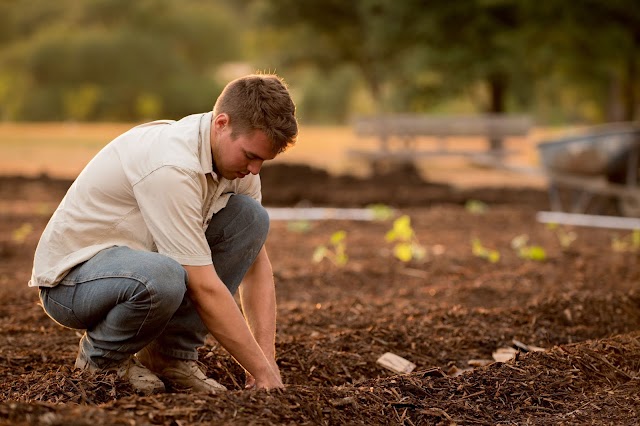Many beginning gardeners tend to overwater their gardens (as do some experienced gardeners). In
general, watering is important in three situations: 1) when you have crops growing, the weather is
warm, and it has not rained for 1-2 weeks, 2) when you have just transplanted a crop and it is not
likely to rain within the next 24 hours, 3) when you have just seeded a crop and it is not likely to rain
within the next week. In the first situation, it may make sense to water the whole garden. In the second and third situations, you may only need to water the newly planted plants or seeds.
If you’re not sure whether or not to water, do this: pull back any mulch, and dig a hole about 10-12
cm (4-5 in) deep. Take some soil from the bottom of the hole and try to squeeze it into a ball. If it
sticks together, you don’t need to water (unless you have a bunch of young, small plants with short
roots). If the soil does not stick in a ball, you may need to water. Sandy soil (see soil) will not ever
form a ball, but if it sticks to your fingers, it’s wet enough.
However you water, it’s best to water thoroughly (meaning, wetting the soil to a depth of 12-15 cm/5-
6 in). Getting water down that far encourages plants to grow deep, strong roots. Getting water that
deep can take considerable time, and as a result, most gardeners tend to water too shallowly.
There is no single recommendation for how long to water, but if your soil seems to be dry based on
the test above, it may take as much as several hours to water your garden thoroughly (the method
you use to water will determine the time it takes).
As tempting as it can be when you’re standing in the garden with a hose in your hand, it’s generally not a good idea to try to water your whole garden by hand – you just won’t be willing to stand there long enough to do the job properly. If you just need to water a few seeds or transplants, and your soil is reasonably moist (from rain or another recent watering), you can get away with a quick hand watering
Overwatering is as bad for plant roots as underwatering. Water your soil until it is moist to the desired depth, but not until the soil is muddy or has water standing on top. Unless you are using drip hoses (and your soil is very dry), watering all night long is a bad idea.
There are, in general, three ways to water your garden – by hand, with an overhead sprinkler, or
with a drip hose or soaker hose at the surface of the ground.
Hand watering
You can water small portions of your garden using a hose with some kind of watering attachment
mounted on the end. There are many kinds of devices – some look a bit like guns and have a trig-
ger you pull to release the water, some look like long wands with fat knobs at the end from which the water comes out. Most of these tools are poorly made. If you can, buy one that is all metal (ideally brass). You could just use a hose with nothing on the end at all, but the flow of water that comes out of a hose can be very strong, and can easily dig up seeds that you’ve just planted. As mentioned above, trying to water your whole garden by hand is a recipe for underwatering.
ger you pull to release the water, some look like long wands with fat knobs at the end from which the water comes out. Most of these tools are poorly made. If you can, buy one that is all metal (ideally brass). You could just use a hose with nothing on the end at all, but the flow of water that comes out of a hose can be very strong, and can easily dig up seeds that you’ve just planted. As mentioned above, trying to water your whole garden by hand is a recipe for underwatering.
Overhead watering with sprinklers
Overhead watering is just what it sounds like: some sort of device
(usually a sprinkler) sprays water over the plants, and it falls down
onto the ground. Overhead watering is simple, but inefficient, because a lot of the water sprayed into the air evaporates before it
hits the ground. Besides the fact that it can damage the leaves of
your plants, watering in the middle of the day in hot weather can
cause as much as 80% loss of water to evaporation. Overhead
watering should always be done in the morning (before 9 or 10
a.m.) or in the evening (after 5 or 6 p.m.).
There are many kinds of sprinklers that vary in cost, efficiency, and durability, as well as in terms of
the area of ground they can cover without being moved. “Fixed” sprinklers spray water out in the
same pattern (usually a square or a circle) all the time. “Oscillating” sprinklers spray water vertically
along a tube that moves back and forth and can be set to cover a circle or any part of a circle.
“Rotary” sprinklers spray water sideways and can be set to cover a circle or any part of a circle.
Most sprinklers are badly designed and/or cheaply manufactured. In general, the best sprinklers are made with metal parts, while the worst ones are all plastic or are plastic with a few metal parts. Dramm is one company that makes good, all-metal sprinklers.
Surface level watering with drip hoses or soaker hoses
Drip hoses and soaker hoses are much more efficient ways to water your garden than are sprinklers.
Drip hoses are hoses that have small holes cut at regular intervals on one side of the hose, while
soaker hoses have small holes cut at irregular intervals all around the hose. Whichever kind you
use (drip hoses are better but not available at some garden stores), arrange the hose to cover the
parts of your garden you want watered, and the hose will slowly but steadily release water into the
soil. Drip and soaker hoses water more slowly than sprinklers, but they use much less water to do
the same job. They are also superior because they don’t wet plant leaves or stems, which can encourage various diseases. Unlike sprinklers, they can be used even in the middle of the day.
Buying hoses
Like hand watering tools and sprinklers, hoses are of varying quality (with most being junk). The
best hoses are thick, heavy, and made of black rubber over a fiber core. Sears sells Craftsman
brand hoses that are usually well made and carry a good warranty (so you can return them if they
fail).
More watering tips
If possible, put your hoses and other watering tools away before winter in a place where they will not
freeze. At the very least, put them in a covered place where they will not get snowed on or exposed
to sun and wind. Use of mulch helps the soil retain water and can reduce the need for watering.










